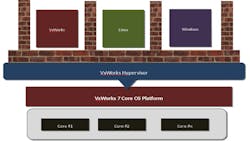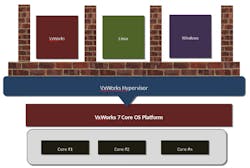VxWorks has long been the RTOS benchmark. It has a long history starting in 1987. Wind River's VxWorks now spans from a tiny 20 Kbyte microkernel version that is ideal of IoT (Internet of Things) devices to 64-bit, multicore platforms (see “VxWorks Goes 64-bit”). The VxWorks Hypervisor provides secure virtualization support (Fig. 1). Wind River is now part of Intel.
The latest incarnation is VxWorks 7 and it brings quite a few new features to table. For example, the new intelligent device profile (IDP) supports the MQTT protocol (see “Understanding The Protocols Behind The Internet Of Things”).
Related Articles
- VxWorks Goes 64-bit
- Development Kits Light Up The Internet Of Things
- MQTT Will Enable The Internet Of Things
- Who’s Doing What In IoT And M2M?
- Understanding The Protocols Behind The Internet Of Things
The VxWorks 7 microkernel uses the same C-level API as the standard kernel but it can fit into tiny, memory constrained platforms. It can support virtual memory hardware but it is not required as it tends to target applications that are more static in nature. It also supports multicore devices. The compact size helps lower safety certification as well as providing a very fast threading model.
The VxWorks Hypervisor has switched from a Type I to a Type II hypervisor. This actually has little affect on virtual machines. It simply places VxWorks at the heart of the virtualization system so it can provide additional functionality. Virtual machines can run additional copies of VxWorks. Linux KVM (kernel-based virtual machine) support is also a Type II hypervisor.
Security is a big aspect of IoT and other application areas targeted by VxWorks including medical and military applications. Wind River highlights VxWorks security support with its four pillars of security (Fig. 2).
Wind River's Eclipse-based Workbench is the first pillar. It can utilize third party static and dynamic analysis tools as well as providing its own hints. For example, it can highlight system calls that may pose a security problem.
VxWorks support secure boot as its second pillar. It can restrict execution of untrusted binaries when the hardware support exists. This is becoming more common and is standard for architectures like Arm TrustZone.
A secure boot is only a starting point since the operating system must then run additional applications. This is where Wind River's policy-based support can be critical. It also applies to all three VxWorks platforms including the microkernerl, standard kernel and hypervisor. The support can also be extended by third parties. Policies can address the entire range of system resources from execution time to file systems.
Finally, VxWorks supports secure file systems. This is critical during execution as well as when a system is powered down. It prevents utilization of data or applications that might be copied from storage devices. VxWorks supports hardware and software encryption.
VxWorks connectivity support has been extended. It now supports USB, CAN, FireWire, Bluetooth including the health device profile . Wind River provides a stack that supports the Continua Alliance for home medical applications . Their dual-mode IPv4/IPv6 has the IPv6 Ready Logo certification.
On the graphics side, VxWorks supports 2D and 3D hardware. It targets open standards like the 2D OpenVG as well as the latest 3D OpenGL ES standard. Board support packages (BSP) will include display drivers that support these platforms including GPU hardware when applicable. The Tilcon Graphic Suite and designer are built on top of these standards.
About the Author
William G. Wong
Senior Content Director - Electronic Design and Microwaves & RF
I am Editor of Electronic Design focusing on embedded, software, and systems. As Senior Content Director, I also manage Microwaves & RF and I work with a great team of editors to provide engineers, programmers, developers and technical managers with interesting and useful articles and videos on a regular basis. Check out our free newsletters to see the latest content.
You can send press releases for new products for possible coverage on the website. I am also interested in receiving contributed articles for publishing on our website. Use our template and send to me along with a signed release form.
Check out my blog, AltEmbedded on Electronic Design, as well as his latest articles on this site that are listed below.
You can visit my social media via these links:
- AltEmbedded on Electronic Design
- Bill Wong on Facebook
- @AltEmbedded on Twitter
- Bill Wong on LinkedIn
I earned a Bachelor of Electrical Engineering at the Georgia Institute of Technology and a Masters in Computer Science from Rutgers University. I still do a bit of programming using everything from C and C++ to Rust and Ada/SPARK. I do a bit of PHP programming for Drupal websites. I have posted a few Drupal modules.
I still get a hand on software and electronic hardware. Some of this can be found on our Kit Close-Up video series. You can also see me on many of our TechXchange Talk videos. I am interested in a range of projects from robotics to artificial intelligence.



